Evolution of Cults
1960s culture birthed the evolution of cults as we know them, from the Masons to Scientology.
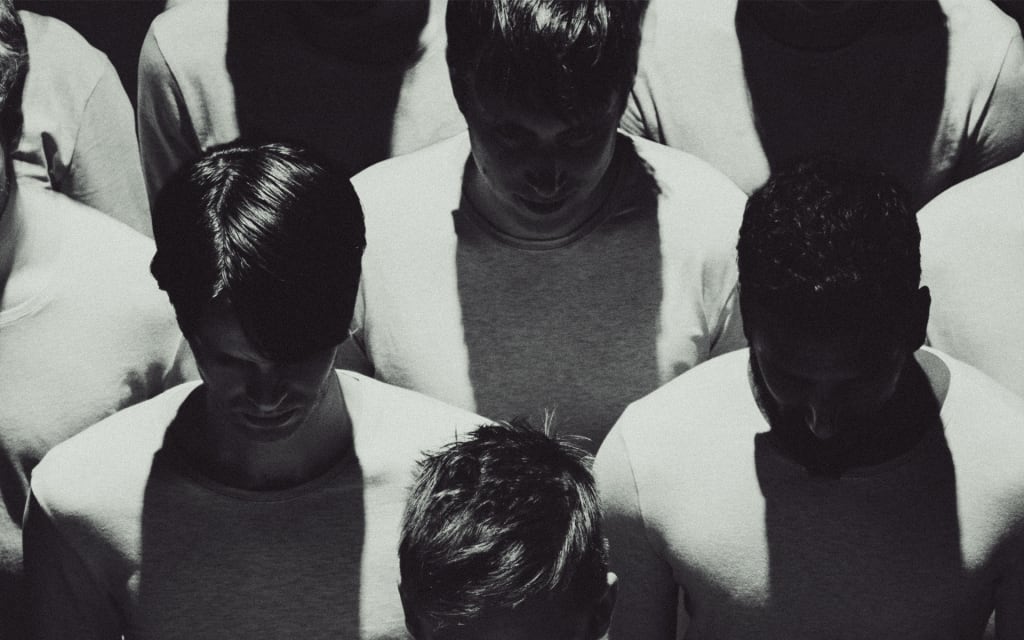
The decline of secret "orders" like the Masons has been balanced by new and weirder quasi-religious sects, which intrigue science-surfeited youngsters with obscure philosophies. The 60s brought with it hippies saying it was the Worst of Times. Respond to the polluted air and the putrid rivers and the unsafe streets by leaving the cities altogether, they said. Dance in tune with nature out beyond cemented-over civilization to find your authentic self. Most of us are not about to take that step, yet we have embraced their entire array of neo-religions, para-religions, pseudo-religions. In a word, cults.
A cult is a quasi-religious group that most consider unorthodox, if not weird or downright menacing. The average citizen is disturbed by anyone who believes in the idea that making salt trails, while circling in the nude with friends, provides insight and inner peace—as do members of witch covens. Yet "one man's superstition is another's religion," said anthropologist Sol Tax. So cults develop into sects, still heretical but more acceptable. And with numbers, wealth, and power, sects grow into full-fledged churches.
Scientology
A case in point is Scientology, started in 1954 as a mixture of the confessional booth, psychoanalytic therapy, and self-actualizing encounter sessions—using the jargon of computer programming. It proved an irresistible combination for the 60s. A US Court of Appeals says it is now a legitimate church and recognizes its central tenet of "auditing" with the Mark V E-Meter. This device, similar to a lie-detector galvanometer, ends in two V-8 cans, or their equivalent. The convert holds them until the readings of his emotional reactions show him to be "Clear." Depending on the number of sessions involved, this process of salvation can cost the convert tens of thousands of dollars. No matter whether the general public considers faith in juice cans as strange, pathetic, or even dangerous, Scientology enjoys full legal protection. This cult's ministers can now marry and bury their own.
Cults and Illicit Drugs
Other cults have not been so lucky with the law. Dr. Timothy Leary tried for years to gain religious status for his League for Spiritual Discovery. This would have enabled his "church" to dispense LSD as an ecclesiastical sacrament the way certain Southwestern Indian tribes can use peyote under the protection of the First Amendment, guaranteeing freedom of worship. Peyote and its active ingredient, mescaline, are otherwise illegal drugs. There was no chance that LSD will become the new government-approved wafer. Notorious tales of wantonness and cruelty in the drug-centered communes of California, New Mexico, and Arizona wove a web of terror around the early cant of love and brotherhood among the flower children. Communes were fertile ground for the development of weird and sadistic cults. Filled with uprooted child-gypsies, ex-mental patients, or petty criminals far from parental or societal control, their proclivities expanded in all directions, their bizarre behavior aggravated the more with the continuous use of perception altering and mood-changing chemicals.
What was more ominous was that their drugs and games were best-sellers in the straight society. In almost all communes, everyone threw pennies to form the six-line hexagram decoded by the I-Ching, an ancient Chinese fortune teller's book. Most could read the tarot, an old European fortune-telling card deck. Many could cast complicated horoscopes. And like the outside world, which had also been bewitched by these things, commune residents went in for numerology, graphology, phrenology, palmistry—all the hoary circus side-show amusements. Ouija boards and crystal balls, once found only at Christmas toy counters, became popular throughout these communities.
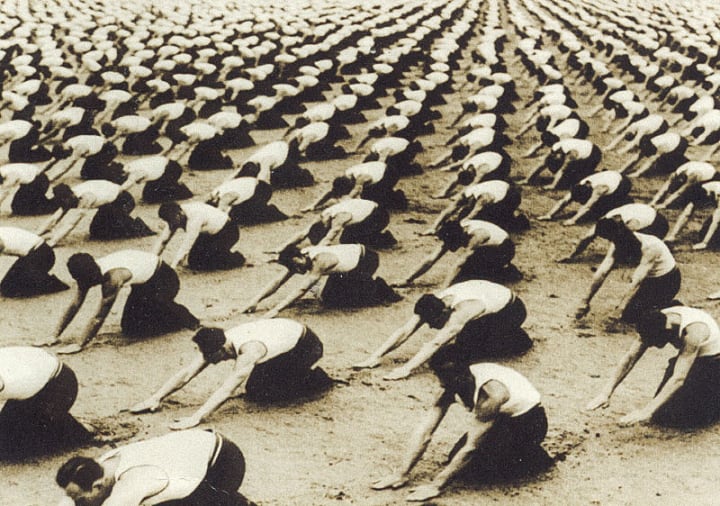
Cults of the Computer Age
This contemporary gothic catalog of diversions is not complete, yet it is already long enough to suggest that the cults of the computer age are different from those that have attracted us before. From Colonial times, Americans have been a collection of thorny individuals who searched each other out to form self-help groups. Though many were steeped in secrecy and ritual, most were quite harmless. Suicide clubs never formed here as they did among the young throughout Europe for decades. A widespread American cult with initiation requirements and rites centered on violence was unknown here until the Hell's Angels and the other motorcycle gangs that emulate them. A cult that dabbles in murder is an ill omen.
Americans in the past have always enjoyed, in fact insisted upon, the notion of "secret," but always meant it as a cover for playful ritual. By 1927, the heyday of fraternal organizations here, there were some 800 secret "Orders" having a combined membership of about 30,000,000. But apart from a few criminal groups like the Tongs, the Mafia, and the KKK, they were social organizations. They had their share of baroque features. Boy's tree-house stuff like secret handshakes and passwords, and super-secret initiation ceremonies like the Mason initiate who bares a breast for a dagger to recreate the death and resurrection of Hiram Abiff, supposedly the Master Architect and Builder of King Solomon's Temple. In some circles it is believed that the power of the mystical number 13 on the Masonic Great Seal has protected the American dollar for generations and always will. Not only the 13 stars for the 13 original colonies, but the 13 letters in "E Pluribus Unum" and the 13 in "Annuit Coeptos" over the occult eye, and the mystic pyramid that has 13 rows of stones, plus the 13 arrows in the left talon of the eagle and the 13 leaves on the branch in its right talon. Every bit of it still printed on the dollar bill and still guarding it.
Social Security in the 30s and prosperity later, plus the arrival of movies and radio meant the beginning of the end for secret societies. And then came the TV. From 900,000 members in 1922, the year Sinclair Lewis published Babbitt, the Knights of Pythias were to shrink to 150,000 within 25 years, and were on their last hurrah by the 60s. The skeleton in the open coffin topped with two crossed swords supporting a Bible—that's the route to self-actualization? But old man Babbitt was not willing to give up the abracadabra of what has become meaningless signs and salutations, nor is his middle-aged son today. It is the grandchildren who have abandoned them altogether.
Even the Masons, seemingly so successful into the 60s with 3,862,138 members (one out of every 12 adult males in the nation) in reality were in grave trouble. The majority of lodges weren't growing, and the organization continued to shrink. Apparently, the society a young man was looking for in the 60s was no longer the all male group that would tide him over when he had no job and take care of his family when died. He wanted more than "fraternity," "fellowship," and "conviviality." He has a rage for "awareness." He yearns for "meaning," "self renewal," "identity."
The activist young became politically involved in student protests, peace marches, ecology demonstrations. They felt themselves to be in control and able to force change. They never reached for the fatalistic, passivistic solutions of impotence like zen or astrology. The cultish young, on the other hand, accepted the analysis that change is beyond us: You can't really fight City Hall.
Coping with the sects that first attracted the Beats and hippies was easy for American churches, some of whom for decades tilted against Western fraternal orders like the Oddfellows and the Elks because they seemed to be "universal religions." The humanist brotherhood religion, if ever it were such, of the Masons, the Rosicrucians, has long since atrophied. The Rosicrucians, a 200-year-old cult that studies mysticism solemnly, appeal to the likes of Robert Kennedy's murderer, Sirhan Sirhan, who described in court how he had joined in 1965 to "better myself mentally" by such instructive occult experiments as staring at dots in two rows until they became one.
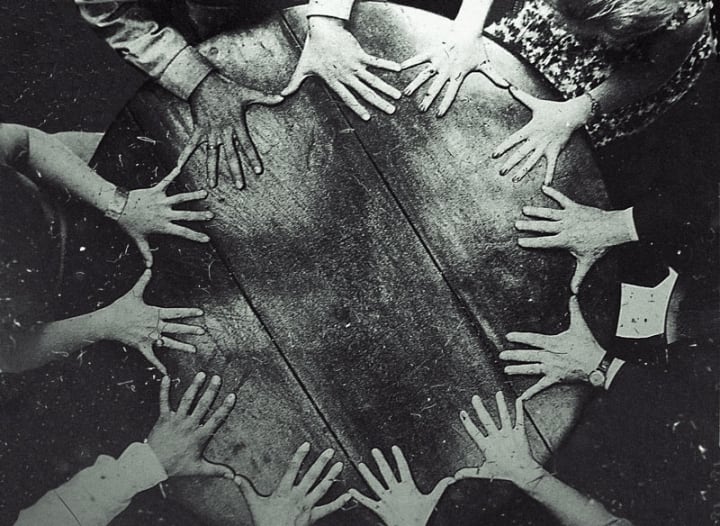
Forgetting the Old and Recognizing the New
It was in the 60s that the Roman Catholic church lifted its 230-year-old excommunication ban against Masons—and not a moment too soon. Attention must be paid to the new cults, now often underground if not secret. While ministers rail against secularism, hedonism, and the affluent society to an aging, dwindling congregation, the young are trying other wafers, other chants, other moralities at strange altars along other roads to the salvation of their souls.
Still, for all their strangeness, even the salvations of the 60s have a history connected with ones we know. Take an unlikely candidate, Hiram Abiff of Masonic legend. He was an archetypal hero who recreated every death-and-regeneration tale from the Egyptian rites of Osiris (where it may have originated) to the acid-head's dangerous killing of his old self-conscious self with LSD. In the tumultuous process of synthesizing Western and Eastern cultures, the middle-aged American, who once bared a youthful breast for the Masonic initiation dagger, will find that, like any good Jungian myth, Hiram serves for all seasons. Even as a bridge to one's disaffected children.
Hiram has many spellings. Only a knowledge of Parhagorian, Chaldean, Cabalistic, and Sufi mysticism will decode them all. But one pronunciation will be instantly understood by all the young who have deserted their parent's churches and synagogues for the varieties of Eastern lore now on our shores. That form of Hiram is Hkur-Om, ending in the most sacred of the Hindu mantras, or incantations, Om. Long before the chanting of Om around the evil-shaped Pentagon in 1967 failed to levitate the building but started us on the uncertain road to peace, drug takers had found another use for it. Hallucinogen experimenters learned the hard way that the safe mind-alterer, once promised by Aldous Huxley, has yet to be discovered. The Om mantra sometimes worked to bring back a quivering soul from a drug trip through doors of perception that had led to a fearsome psychic void. "We'd all hold hands around him and start a quiet steady Om-m-m-m-m. Om has all the vibrations of the universe in it, all the sounds of the open letters and all the sounds of the closed letters. When you permit this celestial hum to pass through you, vibrating with your own hum, peace enters your consciousness."
New Rooted in Old
Such mundane uses of the holy mantra (meditation device) is an Americanization of Buddhist and Hindu techniques that appauls the authentic swamis quite apart from their relentless disapproval of all drug usage. Americans who join the sitting cult of Zen Buddhism find meditation the most difficult art of all. It is incomparably more difficult than learning the lotus sitting position under the tutelage of a swami. "Mantras have a sound scientific basis," says the Maharishi. "Not any type of blood could be infused at random in any type of man. Similarly, each man has his own type of energy impulses which constitute his personality."
Those willing to take the trouble need not make do with the universal mantra Om. A few swamis are able to discover the one syllable that is in tune with one's personal celestial hum. Claiming this power is the Spiritual Regeneration Movement of Maharishi Mahesh Yogi, the man who attempted to lead the Beatles and Mia Farrow to wisdom. The gentle swamis are much maligned in America. The attitude is fostered by the Sunday supplements who persist in calling any group that goes off into the countryside an ashram and labeling whoever seems to be leading the pack a guru.
An ashram is a religious retreat for a group of disciples who come together to learn from a guru, or religious teacher. There are hundreds of yoga classes across the land without gurus. Yoga has almost as many branches as Protestantism, and is well suited to the after five and week-end free time schedule. The standing-on-head position, the king of yogic postures, is particularly recommended for that national majority who wish to stay young-looking. It "reverses the pull of gravity that causes sagging wrinkles."
But there are very few ashrams in the land. For all the talk about the rise of Eastern philosophy here, much of it is dilettantism when it is not simple superstition. Zen retreats are immaculately clean, work-oriented, self-sustaining, and drug-free. Many an acid cripple is finding his way back under the discipline of a yoga or zen ashram, with grateful parental support. By practicing hatha yoga (the physical exercises) and kria yoga (the philosophical ones) the drug experience is recreated under the difficult discipline of yoga breathing exercises which supposedly change the carbon dioxide content of the blood, in turn affecting the brain chemistry.
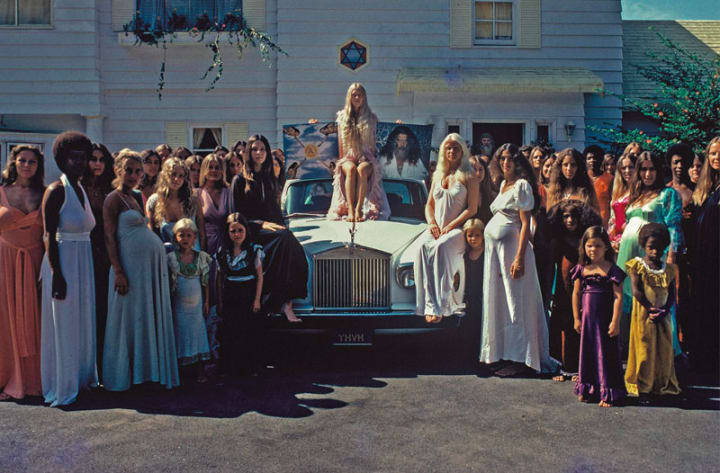
Communes
Mass rejection of material values results in so many different expressions. Those communes, for example. They spread beyond the large Eastern cities and beyond the suburbs of the warm West as early as the 60s. The underground, hip, and New Left press began about that time to report an on-going exodus—groups calling themselves tribes, or communists organized into communes. Generally, a commune consisted of young people in their teens and twenties. White and mostly middle class, from perhaps six to 18 in number, they go to flower-filled farms far away from the cemented-over cities, leaving the constricted apartment homes of their nervous, unhappy parents. They wanted to experience communal living with a joyous extended family.
Allowances, savings, and goods were pooled. They hold their tempers, working on their karma to avoid reincarnation into, maybe, a cockroach. They listen to music, skinny-dip in the farm pond wearing only the standard peace apotropaic, cast each other's horoscopes, share sexual partners in some cases, use drugs when the mood is on them to come alive, and maybe feel God inside themselves.
They chanted Hare Krishna/Hare Krishna/Krishna Krishna/Hare Hare/Hare Rama /Hare Rama/Rama Rama/Hare Hare if they know how. Or they hum Om. This achieves a blending of "the best of Christian ethics—non-violence and love with the mind-expanding disciplines of Eastern faiths."
They licked the 9-to-5 thing, the materialistic soap-and-water system of their plastic up-tight bourgeois parents. The girls ground flour to bake real bread daily and make the Pillsbury slogan their own: "Nothing says lovin' like something from the oven." The boys read Native American how-to-do-it books and build genuine teepees away from the main houses. They let their hair grow. For the first time since the soldiers in the trenches of World War I had cut theirs off to prevent lice infection, males had a new symbol of masculinity. And a quick way to tell everyone, friend and foe, what they stood for.
If the leader of the group was strong and orderly, the farm was clean and the work shared. If not, the house was never swept. Without a nagging mother-type organizer the sheets, where there are any, were never washed. Some ended up doing all the drudgery, then stopped doing it.
The communes were in the vanguard of the turn-on-tune-in electronic tribal culture, children of the computerized Aquarian Age, dropped out first to show us the way to an alternative life style. They were the living, breathing indictment of the capitalistic American Dream. Something new under the American Sun.
Closing Communes
When they broke up, for they seldom lasted six months, sympathetic news accounts from the Watsonal Review to Time said it is a victory for hypocritical, envious Babbitts. The Babbitts have "suppressed desires which they're afraid to satisfy," said sociology professor Allan Crane of the public's disapproving attitude towards the hippie communes.
The communes sometimes became the Sunday rubber-necking tour for nearby townspeople. Occasionally, a fellow from the town misplaced the love part of the group's publicly discussed free love principles and thought something there was free for him, and was unpleasant. More times, foot-loose long-haired gypsies or runaway kids wanted to free-load. The police sometimes closed the places on drug raids.
But harassment was not usually the reason the groups fell apart. Sometimes disease, caused by rats attracted to garbage-strewn sites, decimated a commune. Rampant syphilis or gonorrhea often closed them. But not always. "Tensions got out of hand and we just went our separate ways," sais a Jewish girl of 22 who lived for four months in Forever Free, far from any town, in New Mexico. "But I loved it. It was like a 24-hour group therapy session. There were 14 of us and when you begin to define yourself against so many people, you begin to understand who you are. I learned how to really meditate, to stop all thinking. You have to admit that thinking and reasoning has got us into the mess we're in. But we hadn't figured out how to support ourselves. We were talking of a weaving shop, and our money was running out."
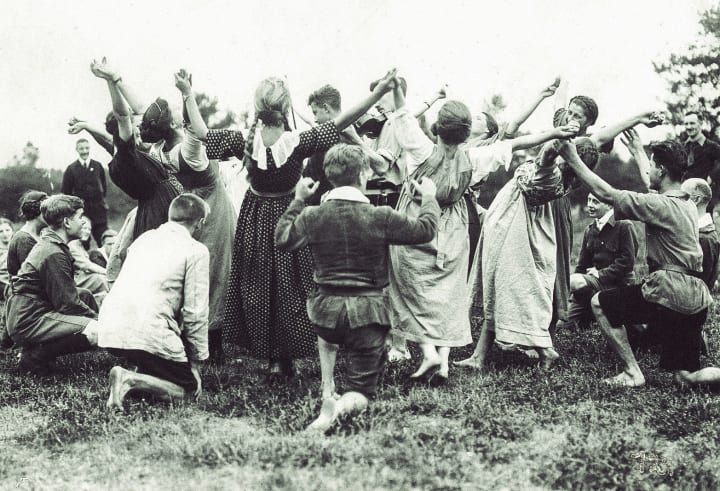
Religion Vs Communes
What was missing in Judaism for her? "I can't worship God in a synagogue. It's too confining. I felt much closer to God running naked through the mountain forest in New Mexico." Nearer my God to thee in the altogether has a long American tradition. Mary Lincoln and her best friend Flavilla Howard, set forth at nightfall to scale the neighboring mountain through slippery mud and driving rain. The year is 1833. The place is Brimfield, Massachusetts. "At dawn, they threw their clothing from them as they ran to stand naked on the summit calling upon Jehovah to stay his avenging bolts."
The account is from the still incredible story of the Oneida, NY commune in Listen for a Lonesome Drum, a perfect the-more-things-change-the-more-they-remain-the-same set of true tales. It was written in 1936 by Carl Carmer. He describes six other cults of the period flourishing in "a hilly strip scarcely twenty-five miles wide" across the state of New York, "a broad psychic highway, a thoroughfare of the occult."
The shaking Quakers, the Mormons, the Jemimakins, the Millerites, the Harrisites, the Spiritualists—by one historian's count the Oneida "Christian Communists" were but one of at least 160 groups (out of a population in the first half of the 19th century that was one-eighth of what it is today) who went out into the American wilderness where the grass is greener, doing their own establishing of their particular Vision of a New Jerusalem.
Those earlier Americans abandoned scrubbed villages, not filthy megalopolises; large families, not atomized ones; craft work, not assembly lines. Yet, unless the cult was able to develop into a sect or an accepted religion, those communes failed for the same reason as modern ones. Apparently, you can't keep them down on the farm grooving on religion and sex. The requirements seem to be leadership, organization, and work. Oneida did survive until it converted into a capitalist cutlery business and married its members. The first and only community dedicated to eugenically planned children.
Oneida, inspired by the religious vision of a twenty-year-old, had no marriages for 38 years among its 280 members. Each was available to everyone of the opposite sex, copulation requiring the permission of the couple involved and the Central Committee. They produced 58 children of which 54 were planned by the Committee, an extraordinary accomplishment in birth control for the time period. They organized and worked so well that they prospered mightily—but it was a bit much for the 19th century. The couples had to pair off in 1879 and marry for the sake of the children and their shares in the business.
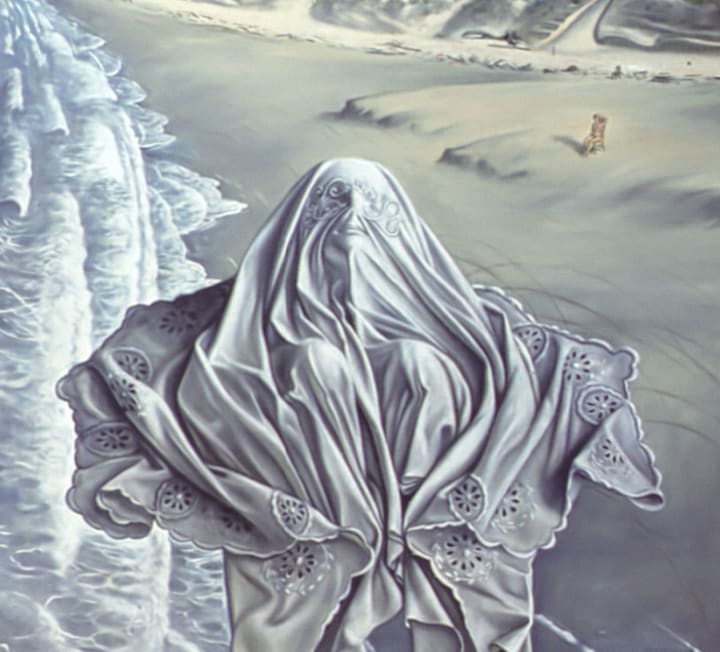
Moving Away from Religion
The political young of the 60s took the content of their Sunday school lessons out into the world attempting to solve social problems the Western churches have themselves defined. These young people never looked to the I Ching, Ouija boards, astrology, or any other childish game for guidance because they knew themselves and their society to be responsible for the world's condition, not their stars. But after joining the civil rights movement, the radical student movement, the anti-war movement—all institutions outside the rectory—there was nothing left in church on Sunday morning to hold their interest any longer. They labeled their churches irrelevant or worse, hypocritical.
However, the youngsters who were non-politically oriented, those who fled the new expressive cults, found the forms of their own churches and synagogues frozen instead of flexible, lacking in feeling, and drama. Lacking in personal involvement or care. They, too, labelled their churches irrelevant and hypocritical, yet they searched for a religious experience as the path to awareness. Names like McCoy, McElroy, Clarke, Anderson, and Cohen make up the list of contributors to the Zen Mountain Center.
A curious paradox: at the very time when the obscure Latin liturgy was discarded in the name of rationality, cults chanting nonsense syllables began sprouting.
The Growth of Eastern Religion in the West
Many other universalist-type Eastern religions began taking hold here in a modest way around the same time. They may well reach as many converts as some of the unusual Christian sects. There is Bahá'í from Persia based on Sufi principles like this one: "Not one of the masters came with the thought of forming an exclusive community, or to give a certain religion. They came with the message from the one and the same God. Whether the message was in Sanskrit, Hebrew, Zend, or Arabic it had one and the same meaning." Any sect with that underlying principle is probably Sufi.
Gurdjieff's Russian mystic cult is a Sufi-inspired system. It trains converts in elaborate dervish dances, sometimes performed on the Ennegram, a circle with a nine-pointed Star inside it, that is the mnemonic key to all knowledge. Gurdjieff disciples say they recapture the authentic religious experience of the ancient days when dancing was always part of religious ritual. Still another Sufi sect is Subud, which came out of Indonesia and has attracted the kind of Protestant who was raised in Pentecostal Christianity. The central experience of Subud, the Latihan, is a quiet time that starts some off to glossolalia, speaking in strange tongues, while others are moved to dervish dancing.
Subud, like all the Eastern philosophies, teaches a universality that troubles the Orthodox Christian. "Here is a means of worship which is pure Content and has no form of its own," says one Subud primer. "Like water it is therefore able to fill the shape of the Christian vessel, the Muslim jar, the Buddhist flask and even the pagan pot." If all this sounds like the church opposed brotherhood of Masonry, that is as it should be. Masonic rituals, words, terms, and all the rest were often Sufi. For instance, this Masonic poem:
The one great God looked down and smiledAnd counted each his loving child.For Turk and Brahman, Monk and Jew,Had reached Him through the God he knew
The theology magazines won't find many better bridges than that. And how odd to find it in a country whose motto is still "In God We Trust" while most of its population uses the churches merely for rites of births, weddings, and funerals. Actually, much of what calls itself a new life style is neither new, nor a style one would choose freely in other circumstances. Many—probably most—of the so-called communes were arrangements for coping with the high cost of living in America. Shared quarters have always been the way out for the poor. These problems, however, did not go away with the communes. These sects of religion, and the problems people seek to solve by following them, are still alive and well, and Americans across the nation continue to follow them.
Cities are also notoriously inefficient places for people to meet each other. "I don't like to go to bars," said an Ohio girl who was miserably lonely in New York for almost a year until she found the variety of cult activity in town. "Now I go to a Spiritualist church one night a week, to Synanon Singles another night, and to the Subud Latihan a third night. It scarcely costs anything."
Amateurs guiding amateurs, and amateurs alone can be tragically destructive. They understand so little of the truly depressed, the anxious, the Sado-masochists. How is the tarot death card handled if one really believes that it shows what is fore-ordained? Is it turned into a self-fulfilling prophecy?
Consider what Eileen Garrett, the famous British medium whose occult powers she could never explain, said a long time ago about the people attracted to astrology and phony supernatural namby-pamby. She called it "The Fascist Impulse and warned against cults whose leaders spoke of "God in me." The public rigmarole of a quaint cult, now as then, can be a long way from what it's really all about.
Learn More About Cults
Here we have looked at how cults evolved from the time of the Masons into the cults of the 60s that we recognize today. To delve deeper into these cults and to explore in depth the impact they had on society, read Cults: In Too Deep From Jonestown to Scientology.
Cults: In Too Deep From Jonestown to Scientology looks at 20th and 21st century cults, as well as the 1960s culture that birthed these organizations. The volume takes an in-depth look at America's religious and social cults, their leaders, and the impact they have had on the lives of those that joined them.
About the Creator
Futurism Staff
A team of space cadets making the most out of their time trapped on Earth. Help.






Comments
There are no comments for this story
Be the first to respond and start the conversation.